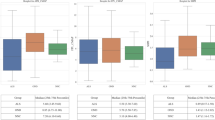Abstract
Amyotrophic lateral sclerosis (ALS) has a peculiar involvement pattern; clinically it is known as split hand syndrome and electrophysiologically shows abnormalities in the abductor pollicis brevis (APB)/abductor digiti minimi (ADM) ratio. The aim of this study was to find a significant electrophysiological parameter in upper limb onset ALS patients with normal APB/ADM ratio when compared to cervical spondylotic amyotrophy (CSA) and healthy controls. We retrospectively reviewed the electrophysiological results of 47 upper limb onset ALS and 42 CSA cases; 20 healthy individuals were included as controls. We included ALS and CSA patients with normal ADM/APB ratio (≥0.6, and ≤1.7), and the parameters of electrophysiological study were compared. The electrophysiological parameters of statistical significance among ALS, CSA and normal controls were: amplitude of median and ulnar nerves, the terminal latency of median nerve, F-wave latency of median and ulnar nerves, terminal latency ratio of ulnar/median nerves, and F-wave latency ratio of ulnar/median nerves (p < 0.05). Among these parameters, the terminal latency ratio of ulnar/median nerve and terminal latency of median nerve in ALS were significantly different with both of CSA and normal control (p < 0.006). The abnormality in the terminal latency of the median nerve can be partly explained by the distal motor axonal dysfunction due to sodium and potassium channel abnormalities. The hypothesis of distal axonopathy is known to play an important role in the pathogenesis of ALS causing a significant prolongation of the terminal latency in the median nerve and the ulnar/median nerve ratio.



Similar content being viewed by others
References
Vucic S, Ziemann U, Eisen A, Hallett M, Kiernan MC (2013) Transcranial magnetic stimulation and amyotrophic lateral sclerosis: pathophysiological insights. J Neurol Neurosurg Psychiatry 84(10):1161–1170
Jin X, Jiang JY, Lu FZ, Xia XL, Wang LX, Zheng CJ (2014) Electrophysiological differences between Hirayama disease, amyotrophic lateral sclerosis and cervical spondylotic amyotrophy. BMC Musculoskelet Disord 15:349
Wilbourn AJ (2000) The “Split hand syndrome”. Muscle Nerve 23:138
Eisen A, Kuwabara S (2012) The split hand syndrome in amyotrophic lateral sclerosis. J Neurol Neurosurg Psychiatry 83:399–403
Kuwabara S, Mizobuchi K, Ogawara K, Hattori T (1999) Dissociated small hand muscle involvement in amyotrophic lateral sclerosis detected by motor unit number estimates. Muscle Nerve 22(7):870–873
Kuwabara S, Sonoo M, Komori T, Shimizu T, Hirashima F, Inaba A et al (2008) Dissociated small hand muscle atrophy in amyotrophic lateral sclerosis: frequency, extent, and specificity. Muscle Nerve 37(4):426–430
Menon P, Kiernan MC, Yiannikas C, Stroud J, Vucic S (2013) Split-hand index for the diagnosis of amyotrophic lateral sclerosis. Clin Neurophysiol Off J Int Fed Clin Neurophysiol 124(2):410–416
Ludolph A, Drory V, Hardiman O, Nakano I, Ravits J, Robberecht W et al. (2015) A revision of the El Escorial criteria—2015. Amyotroph Lateral Scler Frontotemporal Degener 16(5–6):291–292
Inui Y, Miyamoto H, Sumi M, Uno K (2011) Clinical outcomes and predictive factors relating to prognosis of conservative and surgical treatments for cervical spondylotic amyotrophy. Spine 36:794–799
Lyu RK, Huang YC, Wu YR, Kuo HC, Ro LS, Chen CM et al (2011) Electrophysiological features of Hirayama disease. Muscle Nerve 44(2):185–190
Weber M, Eisen A, Stewart H, Hirota N (2000) The split hand in ALS has a cortical basis. J Neurol Sci 180:66–70
Kanai K, Kuwabara S, Misawa S, Tamura N, Ogawara K, Nakata M et al (2006) Altered axonal excitability properties in Amyotrophic lateral sclerosis: impaired potassium channel function related to disease stage. Brain 129:953–962
Kanai K, Shibuya K, Sato Y, Misawa S, Nasu S, Sekiguchi Y et al (2010) Motor axonal excitability properties are strong predictors for survival in Amyotrophic lateral sclerosis. J Neurol Neurosurg Psychiatry 83:734–738
Vucic S, Kiernan MC (2010) Upregulation of persistent sodium conductances in familial ALS. J Neurol Neurosurg Psychiatry 81:222–227
Bae JS, Sawai S, Misawa S, Kanai K, Isose S, Kuwabara S (2009) Diffrences in excitability properties of FDI and ADM motor axons. Muscle Nerve 39:350–354
Shibuya K, Misawa S, NasuS Sekiguchi Y, Mitsuma S, Beppu M et al (2013) Split hand syndrome in amyotrophic lateral sclerosis: different excitability changes in the thenar and hypothenar motor axons. J Neurol Neurosurg Psychiatry 84:969–972
Fishcer LR, Culver DG, Tennant P, Davis AA, Wang M, Castellano-Sanchez A et al (2004) Amyotrophic lateral sclerosis is a distal axonopathy: evidence in mice and man. Exp Neurol 185:232–240
Noto Y, Kanai K, Misawa S, Shibuya K, Isose S, Nasu S et al (2011) Distal motor axonal dysfunction in amyotrophic lateral sclerosis. J Neurol Sci 302:58–62
Acknowledgements
No commercial party having a direct financial interest in the results of the research supporting this article has or will confer a benefit upon the authors or upon any organization with which the authors are associated.
Author information
Authors and Affiliations
Corresponding author
Ethics declarations
Conflict of interest
The authors declare that there is no conflict of interest regarding the publication of this paper.
Rights and permissions
About this article
Cite this article
Park, D., Park, JS. Terminal latency abnormality in amyotrophic lateral sclerosis without split hand syndrome. Neurol Sci 38, 775–781 (2017). https://doi.org/10.1007/s10072-017-2842-8
Received:
Accepted:
Published:
Issue Date:
DOI: https://doi.org/10.1007/s10072-017-2842-8



